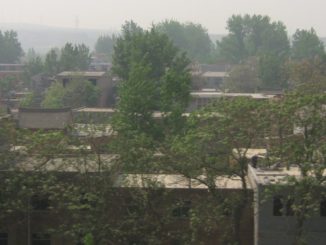It takes a week to cycle from Penzance to Berwick. It took me 40 years. Because on the way, I wanted to include every town in England, in what amounted to some two years of day-rides. Most of these rides were point-to-point, but some were loops, and some looked on the map like a dropped noodle. It wasn’t a continuous line, but many separate lines, and all rides included towns I had not visited before. I used trains to get to starting points. Each ride had to be at least 20 miles, and in each new town, I had to touch a central feature, ideally the market cross or town hall. This is just one of hundreds of rides on this lifetime’s journey. A few more journey writeups can be found at my “Riding the Shires” website, from which this was taken, at Riding the Shires. Half a century of cycle-touring. (along with a couple of long memoires of the Soviet bloc).
I have to begin this next writeup with a confession. Though I did regard Berwick (see previous account) as the end of the road in psychological terms, technically it wasn’t. There were still a dozen or so remote towns that I hadn’t done, and, in the Penzance-Berwick line, one short link was still needed. That short link was Newcastle to Morpeth. A couple of months after Berwick, in late 2019, I filled this gap, only the other way round.
For late November, the weather was reasonable — breezy, mild and cloudy with light showers. Ordinarily, I wouldn’t have done it at this time of year, with the days now so short, but I had another reason for coming back up to the northeast, involving the passport office in Durham, so I killed two birds with one stone. The Durham business took half the morning, so it was already one o’clock when I wheeled the bike out of Morpeth station. Minus all my maps, as I’d stupidly left them in the passport office. Lacking a smartphone and too tight-fisted to buy expensive new OS sheets, I decided to try to do this short spin by intuition and memory. I’d never ridden without maps before, but what the heck. The route was simple — main roads to the coast at Blyth, and then turn south. All I had to do was keep the sea to my left. How hard could it be?
Well, to my surprise, memory served me well and I was indeed able to navigate map-lessly, by the signposts and wind and sun alone. I didn’t see much of the sun, but the gusts were quite strong. And favourable, a northerly, which was a real bonus. So I headed across the North Tyne coalfield to Bedlington, six miles or so off. This was an old pit town I’d never heard of, rising from the bank of the River Blyth. Despite its industrial past, it remained a market town at heart, with a long high street lined with old sandstone shop and house fronts , though it did not want for postwar eyesores, notably the premises occupied by the Co-Operative funeral service.
I planted a foot on the market cross, a simple tapering stone column, and wandered over to the most handsome of the old façades. It turned out to be a pub that had been the birthplace of Daniel Gooch, one of the many unsung pioneers of the age of industrialisation. Men I now view with more respect and interest than the writers and other worthies you’re taught to revere at school. Never mind Wordsworth and Milton. My heroes are the inventors of the vacuum cleaner and the elevator, of shampoo, the toilet cistern and the calculator. And the men whose shoulders they stood on, like the Belgian Solvay, whose ammonia process launched the modern chemical industry, and Bessemer, the inventor of the technique for cheap mass-production of steel, the foundation of just about every convenience today.
Gooch made his name in dull stuff like locomotive design and deep-sea cable-laying. But I didn’t need the details. I just loved the idea that no matter how obscure or depressed an English town, you always have a good chance of stumbling on the childhood home of a Gooch or some other architect of modern prosperity for the world. And so much the better to find that his old home had become a pub.
Onward, then, across undulating but not difficult country, to Blyth. About this port I knew nothing either, except that for several years political pundits constantly referenced it when reaching for a typical Brexit-supporting northern town. The approach was anything but typical. Blyth offered up one of the most surreal spectacles I have ever seen from a bike saddle. Towering over the rooftops was a cargo ship, not on the sea, but raised a house’s height above it on scaffolding — a great hull seeming to hang in the air beyond the Asda and the rows of little Victorian chimney pots, like a moored Zeppelin.
Once a mining and shipbuilding town — it built the Ark Royale — Blyth today lives from vessel maintenance and repair services. Its waterfront was dotted with gantries, cranes and other heavy lifting gear, along with rows of huge grain and other storage tanks. A single long street divided the big industrial yards from the grey grids of terraced streets where all the grubby Leave voters lurked. But the thing I remembered Blyth for was six repeated words of graffiti in the outskirts among the estates: Damien Craven Grass, and Ray Palmer Grass, on the side of the Asda superstore. Astonishingly, Asda hadn’t bothered to erase them. I’m not sure what all that says about this community, but it sure didn’t tempt me to check out house prices.
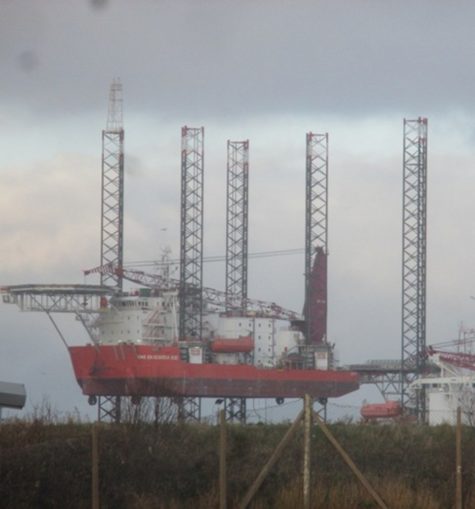
Above and below, Blyth scenes
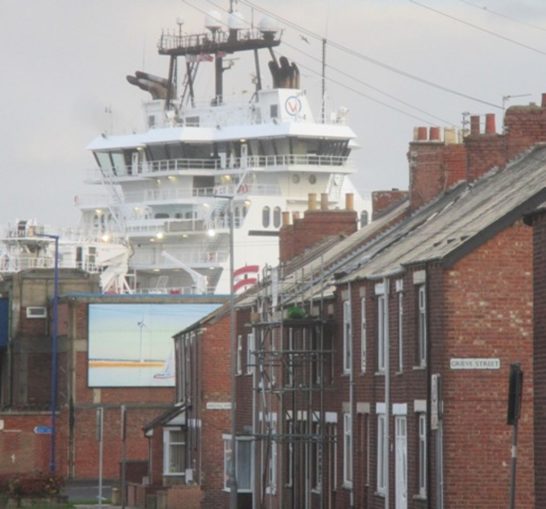
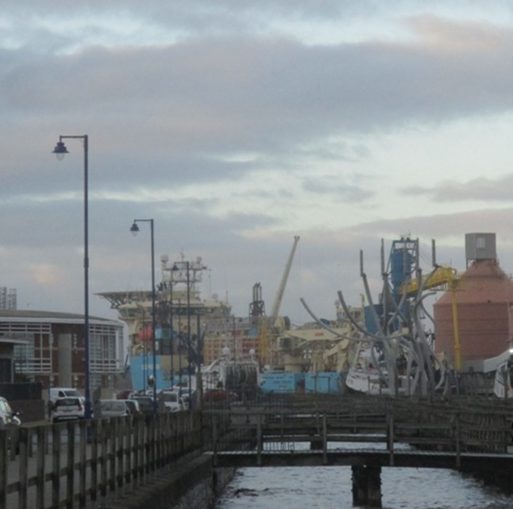
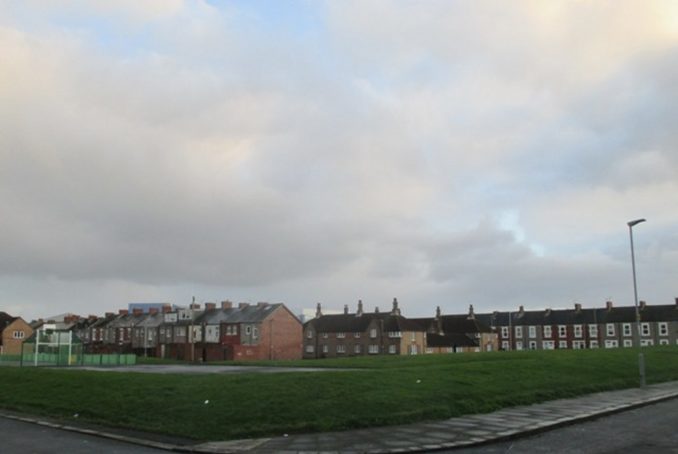
On the edge of Blyth was another little surprise, an attractive sandy beach with boats and painted beach-huts. Here, the northerly breeze got squarely behind me and seemed to suddenly stiffen into a gale. For the rest of the afternoon, it provided an assist so powerful it was like riding an electric. That was just as well, as I was once again racing the declining daylight. It blew me right down to Tynemouth in less than an hour, making this one of the fastest touring rides I’ve done.
At the end of the long beach was Seaton Sluice, a few miles from the village of Seaton Delaval, a name I have known for decades from a very fine folksong:
Delaval is a terrible place
They rub wet clay in the blackleg’s face
Around the pits they run a foot race
To catch the blackleg miner
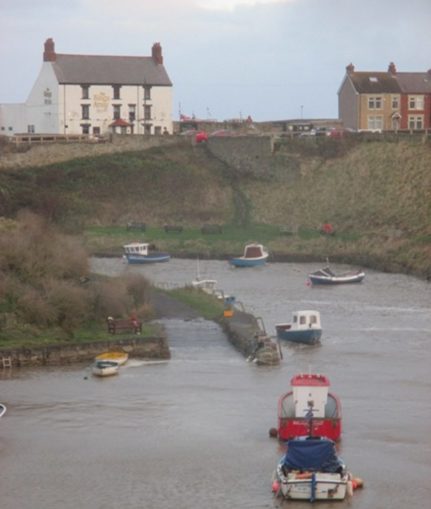
The clouds were heavy now and the North Sea was in an ugly mood. At Whitley Bay, Cullercoats and Tynemouth, waves were pounding the cliffs and shattering into great plumes of foam a hundred feet high. Whitley Bay was completely different in character from Blyth. This was a genteel-looking resort with a fine array of hotels. At their foot was the Spanish City, which I knew from another song, this time by Dire Straits.
In fact, I thought Dire Straits had made this place up. But the Spanish City is real, a big white domed palace of entertainment on the shore, built originally in 1910, and a landmark on the Geordie coast which over its long life served as a circus with “telegraph wire cyclists,” a menagerie, a ballroom, a barrack, a bingo hall, a shopping centre and much else. After several troubled decades, it had just reopened.
Whitley Bay, a plaque stated, was just plain Whitley until the 1890s, by which time confusion with Whitby, also on the northeast coast, regularly caused mail to be misdirected. The final straw came in September 1901, when a Whitley resident died in Edinburgh and was taken to Whitby for burial. Many residents rejected the name change and still refer to their town as plain Whitley, without the Bay.
Tynemouth was also a surprise. The name suggested docks and shipyards. Instead, it was more like an old English coaching town, which in fact is what it once was, for the old Carlisle post road along Hadrian’s Wall ended here. Its bustling main drag, early Victorian in flavour, was complemented by a ruined priory and castle standing starkly atop the bleak promontory at the mouth of the Tyne, against which the crashing waves rhythmically sent up towers of spume. No time to visit. I headed back into town and put my foot on the little Italianate (“Venetian Gothic” said the blurb) clock tower
The ride was over really, as some would say Tynemouth is actually a suburb of Newcastle, being an end of the Tyne conurbation. Others not. Either way, it was now dark, and I didn’t fancy 15 miles of urban riding even though this time I had actually managed to bring working lights with me. I took a train into town.
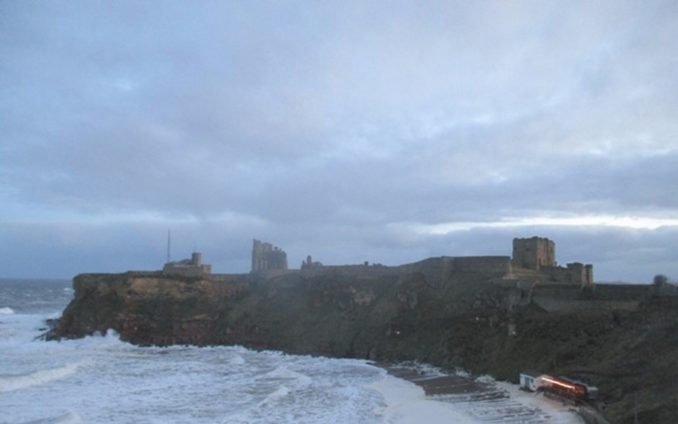
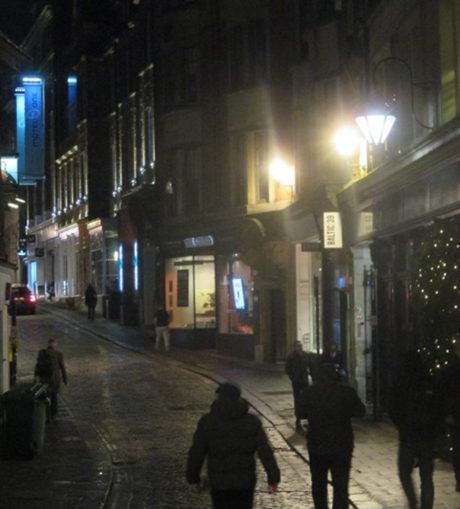
As soon as it had pulled away, a voice in my head spoke up. Wasn’t this cheating? Yes, it was. I got off again a few miles on at North Shields — the kind of place they put the breast-screening and vehicle-licensing agencies to spread the jobs around — and rode to Wallsend, which would complete the long chain.
It was a long, tough and joyless final leg, involving difficult junctions, a surprising number of hills and a whole lot of rain, for with the onset of darkness the clouds had opened. At Wallsend, which I’d ridden to before, I considered it job done and trained into Newcastle. The road from Manors to the main station took me down three steep cobbled streets, all glistening in the wet, and past spires and battlements. For a few moments, I was back in Malá Strana in Prague. Newcastle is an endlessly astonishing city. You tend to forget that it is no Victorian upstart like Manchester, but has a Norman castle and an Elizabethan waterfront.
So I had finally made it, from Deal to Silloth, from Yarmouth to the Welsh border, from Lands End to Berwick. Minus three miles between Tynemouth and North Shields. I’d have to come back for that.
But then I changed my mind. So what, I thought in the train back south. Let that link stay missing. If you enjoy doing something, stop just before satiation. Wasn’t it better that way?
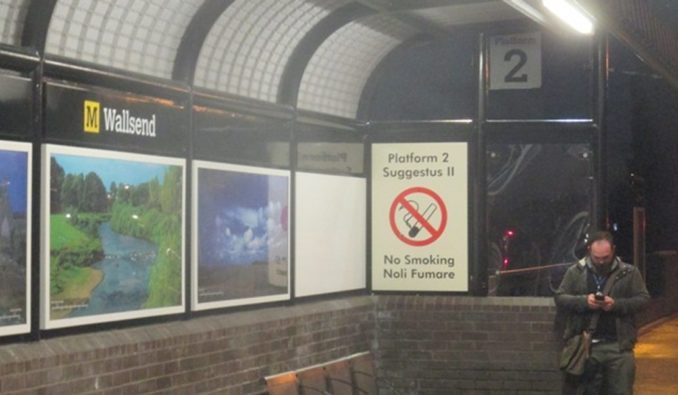
More like this can be found at my website Riding the Shires. Half a century of cycle-touring.
I’m fine with being quoted (up to two paragraphs), but all rights @joeslater.
© text & images Joe Slater 2025

